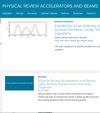重离子同步加速器中的光束晕准直
Physical Review Special Topics-accelerators and Beams
Pub Date : 2015-08-05
DOI:10.1103/PHYSREVSTAB.18.081001
引用次数: 5
摘要
本文系统地研究了同步加速器中质子至铀离子束的晕准直。以计划中的反质子和离子研究同步加速器SIS100为参考案例。这些概念被分为完全剥离(例如,238 U 92þ)和部分剥离(例如,238 U 28þ)离子准直。两级质子加速器准直系统的应用,建立了质子加速器,也打算完全剥离离子。两级系统由主准直器(散射箔)和次准直器(大体积吸收器)组成。利用FLUKA模拟了粒子与主准直器的相互作用(散射、动量损失和核相互作用)。利用MAD-X进行粒子跟踪模拟。最后,确定了准直效率与主离子种类的关系。估计了准直系统调整、点阵缺陷和光束参数的影响。部分剥离离子的准直概念采用薄剥离箔来改变它们的电荷状态。这些离子随后使用光束光学元件向倾倒位置偏转。用GLOBAL得到了剥离箔后的电荷态分布。离子被用MAD-X跟踪。本文章由计算机程序翻译,如有差异,请以英文原文为准。
Beam halo collimation in heavy ion synchrotrons
This paper presents a systematic study of the halo collimation of ion beams from proton up to uranium in synchrotrons. The projected Facility for Antiproton and Ion Research synchrotron SIS100 is used as a reference case. The concepts are separated into fully stripped (e.g., 238 U 92þ ) and partially stripped (e.g., 238 U 28þ ) ion collimation. An application of the two-stage betatron collimation system, well established for proton accelerators, is intended also for fully stripped ions. The two-stage system consists of a primary collimator (a scattering foil) and secondary collimators (bulky absorbers). Interaction of the particles with the primary collimator (scattering, momentum losses, and nuclear interactions) was simulated by using FLUKA. Particle-tracking simulations were performed by using MAD-X. Finally, the dependence of the collimation efficiency on the primary ion species was determined. The influence of the collimation system adjustment, lattice imperfections, and beam parameters was estimated. The concept for the collimation of partially stripped ions employs a thin stripping foil in order to change their charge state. These ions are subsequently deflected towards a dump location using a beam optical element. The charge state distribution after the stripping foil was obtained from GLOBAL. The ions were tracked by using MAD–X.
求助全文
通过发布文献求助,成功后即可免费获取论文全文。
去求助
来源期刊
自引率
0.00%
发文量
0
审稿时长
3-8 weeks
期刊介绍:
Physical Review Special Topics - Accelerators and Beams (PRST-AB), is a peer reviewed, purely electronic journal, distributed without charge to readers and funded by contributions from national laboratories. It covers the full range of accelerator science and technology: subsystem and component technologies, beam dynamics; accelerator applications; and design, operation, and improvement of accelerators used in science and industry. This includes accelerators for high-energy and nuclear physics, synchrotron radiation production, spallation neutron sources, medical therapy, and intense beam applications.

 求助内容:
求助内容: 应助结果提醒方式:
应助结果提醒方式:


